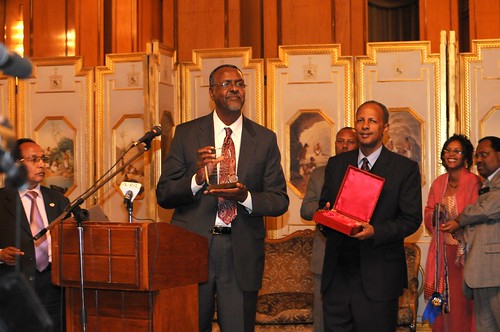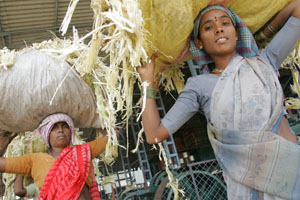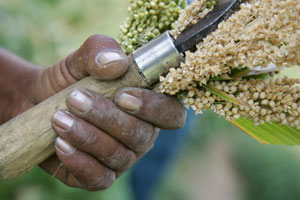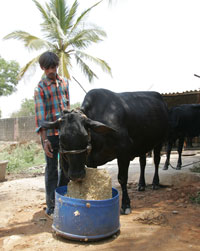Scientist whose work has enhanced the food supply of hundreds of millions of people
in sub-Saharan Africa is honoured in Ethiopia
At a reception at the National Palace in Addis Ababa, Ethiopia, following a ‘Dialogue on Agricultural Development in Ethiopia’ on 12 November 2009, Ethiopia’s president, H.E. Ato Girma Woldegiorgus, bestowed his country’s highest award for achievement on Prof Gebisa Ejeta, an Ethiopian-born sorghum breeder and recent World Food Prize Laureate. In response, Prof Ejeta announced that he will use his USD250,000 World Food Prize award to establish a foundation that will help meet the educational needs of Ethiopian and other African children and to establish an annual dialogue in honour of his friend and mentor, Dr Berhane Gebre-Kidan, formerly of Ethiopia’s Alemaya College of Agriculture.
At his Palace reception, Ejeta was visibly moved by his country’s honour.
‘To receive from my country the highest recognition any Ethiopian can receive is overwhelming,’ said Ejeta. ‘All other recognitions I have received I have taken on behalf of the causes I have served. But I am happy to take this particular recognition personally.’
Ejeta, a self-described ‘typical Ethiopian’, said he had spent his life working to serve three principles: humility, integrity and loyalty. ‘I have always tried to remain in check with myself, my own sense of purpose,’ he said. ‘You have to have some cause bigger than yourself. Mine has been to work in service of humanity and the poor.’
Ejeta said, ‘With the money I received from the World Food Prize, I am putting together a foundation. We will use this award money to help meet the educational needs of Ethiopia and other African children.’
He then went on to make a second announcement.
‘Dr Berhane Gebre-Kidan has served as a friend and mentor since I met him at my alma mater, the Alemaya College of Agriculture. I want to establish an annual dialogue, the “Berhane Gebre-Kidan Dialogue”. I cannot think of a better venue to make this announcement, honouring my mentor.’
The 2009 World Food Prize was presented to the Ethiopian-born plant scientist, now an American citizen conducting research at Purdue University, in ceremonies in Des Moines, Iowa, on 15 October 2009. The prize, which comes with a USD250,000 award, is given annually to people who have helped address the world’s food needs. This year’s prize honours Ejeta’s life-long work to improve the production of sorghum, one of the world’s most important grain crops. It also honours his efforts to make his discoveries matter to the farmers who need them the most.
Humility
Ejeta’s desire to help others is rooted in his own childhood poverty. He grew up in a one-room thatched hut in rural Ethiopia. His mother’s commitment to his education helped make him a standout. Poor as she was, she found a place for Ejeta to study, and a place to stay, in a town 20 kilometres away. Ejeta walked there. He studied there. He worked hard there. He excelled there.
Lowell Hardin, an emeritus professor at Purdue University who has known Ejeta for 25 years, says, ‘Because he grew up in very, very modest circumstances — a single mother in a remote village in Ethiopia — he knew poverty. He knew hunger. And when he was fortunate enough to get an education thanks to his mother’s pushing, he decided he was going to apply his talents in this direction.’
Integrity
Ejeta has spent his entire professional life in research to reduce threats to Africa’s food crops. He applied his talents to fighting a weed called Striga, or witchweed, which threatens crops that feed more than 100 million people across sub-Saharan Africa. Ejeta says the parasitic weed can ruin fields of sorghum, a major staple in hot, dry regions of Africa.
‘If you grow a crop susceptible to infection by the parasite,’ he says, ‘and if your soil is contaminated, you have no chance of growing a crop. And most of these soils are becoming contaminated.’
Researchers had tried for years to control the weed without much success. Its seeds can lie dormant in the soil for decades. But Ejeta and his team at Purdue University discovered the chemical signals produced by the sorghum plant that ‘wakes up’ the Striga seeds. They then found sorghum varieties that didn’t produce the signals, and bred a line of Striga-resistant plants that thrived in a broad range of African growing conditions. These new varieties produced up to four times more grain than local types, even in drought-plagued areas.
Loyalty
With this research breakthrough, Ejeta immediately set about ensuring that his disease- and drought-resistant varieties were made available to the African farmers who needed them most. Once the new variety was developed in 1994, he worked with non-profit groups to distribute eight tons of seed to twelve African nations.
Carrying research to the next level is typical of Gebisa Ejeta, who has always understood the importance of getting technology into the hands of African farmers. Just out of graduate school, he bred a high-yielding, drought-tolerant variety of sorghum. When the new hybrid variety was introduced in 1983, Ejeta worked with Sudanese farmers’ cooperatives to scale up production of his drought-resistant sorghum.
Today, Ejeta is working with local partners to connect brewers, bakers, and flour millers with farmers growing the improved sorghum. By working along the entire chain, from farmers’ seeds to consumers’ plates, his work is helping to lift people out of poverty—and providing a powerful weapon in the war on hunger.
Dialogue
The 12 November 2009 ‘Dialogue on Agricultural Development in Ethiopia’ was organized by the Ethiopian Ministry of Agriculture and Rural Development in Ejeta’s honour. Supported by the International Livestock Research Institute and other organizations, the Dialogue was opened by H.E. Ato Girma Woldegiorgis, President of the Federal Republic of Ethiopia.
President Woldegiorgis called Ejeta ‘an Ethiopian champion whose prize is a commitment to others. Through much of our history, we have made scientific discoveries. With this recognition of Dr Gebisa, we reclaim that history.’
In his welcome address, H.E. Ato Teferra Derebew, Minister of Agriculture and Rural Development, noted how much the Ethiopian Government has emphasized agriculture in its development program and said, ‘Gebisa represents a new generation of agricultural researchers. The farming and pastoral societies of Ethiopia are grateful.’
Ejeta on Ethiopia’s challenges and opportunities
In his presentation, Prof Ejeta spoke about Ethiopia’s role in enhancing science-based development in Africa. Whereas most African governments have invested too little to create impact, he said, Ethiopia is an exception.
‘No other African country has committed more internal resources to agricultural development,’ Ejeta said. ‘I have grown positive about Africa lately. Ethiopia is at the cusp of a major agricultural revolution. Ethiopians are among the most resourceful people I know. They can focus and get it done.’
He extolled two great examples of technology transfer in Ethiopia: the Chilalo Agricultural Development Unit in 1970s and the work of Sasakawa Global 2000 in 1990s. ‘Neither,’ he said, ‘was sustained.’ Why not?
‘I am defined,’ Ejeta said, ‘by the modest background that I come from and the great education that I have received in both Ethiopia and the United States.’ In his experience, he said, both Alemaya College of Agriculture and Purdue University shared a ‘land grant university model’ that takes the results of research and delivers it to communities.
‘More buildings and more students don’t make a college,’ he warned. ‘The quality of education in Africa needs to be improved. We need to go back to the model we used 40–50 years ago. We need to get our colleges linked to outstanding universities overseas. The most significant mark that we can make is capacity strengthening.’
Among his worries, Ejeta said, were an uncoordinated national agricultural research framework and what he called the ‘seasonality and fragmentation of development efforts.’
‘For too long we have relied on external funding,’ he said. He warned of the tendency of non-governmental organizations to lobby for boosting social service spending and the susceptibility of donors to embracing paradigm shifts, from sustainable agriculture in the 1990s, for example, to today’s integrated value chain approach. Such frequently changing paradigms, he said, ‘have led to a series of failed starts and are partly responsible for our lack of traction on the ground in agricultural research for development.’
‘African science-led agricultural development needs to be country led,’ he said. ‘Our country programs must be front and centre, with international agricultural research institutes and non-governmental organizations working to support them.’
Ejeta advised the Ethiopian agricultural research-for-development community to ‘Loosen up, be open and take risks’ and to focus on three things: accelerating technological development, investing in institutions and pushing for policy and ownership.
Panel on climate change and African agriculture
Three other presentations on the achievements and future of Ethiopian agriculture and agricultural research were followed by a panel discussion. Several of the panel members spoke on the new challenges Ethiopian and African food producers face with climate change. Dr Mata Chipeta, working for the Food and Agriculture Organization of the United Nations in its Ethiopia sub-regional office, said, ‘Climate change is likely to worsen our food security problems. Climate change could become just the latest excuse for Africa not to be food sufficient. Last year’s fuel price hikes and then fertilizer, food and financial crises are all interlinked. Africa must become master in its own house. It must stop feeling entitled to free assistance. It must invest its own resources. Only then will we get a future that we drive.’
Dr Carlos Seré, director general of the International Livestock Research Institute (ILRI), whose principal campuses are located in Ethiopia and Kenya, spoke of the need to enhance the capacity of societies to learn quickly and respond to climate and other changes. ‘I don’t think there is a trade-off between climate change and food security,’ Seré said. ‘Our agricultural and climate challenges have much in common. Agriculture has to be central to climate change discussions.’
The ILRI director general remarked on Ethiopia’s rare agricultural, biological, human and institutional diversity: ‘There will be a lot of variability in how the climate changes. Ethiopia has greatly diverse farming regions. It has great biodiversity. How can we use cutting edge science to understand that diversity and use it better? Lessons learned in one place may be valuable in another. We need to empower people at the local level to provide solutions. Science can quicken this work. The centres of the CGIAR have been working side by side with the Ethiopian Institute of Agricultural Research and other institutions in this country. We stand ready to deepen our cooperation with the diversity of institutions in Ethiopia.’
Regular dialogue begins
Fittingly, the person whose remarks closed the Dialogue was Prof Ejeta’s mentor, Dr Berhane Gebre-Kidan, who had attended the October World Food Prize ceremony in Iowa, where he watched his protégé be honoured.
Recalling that Ejeta had attended Jimma Agricultural Technical University, Alemaya Agricultural University and then Purdue University, Gebre-Kidan said that each of these institutions shared the land grant philosophy, which combines education, research, and extension, all involved in the development of its local communities.
‘I wait for the day,’ Gebre-Kidan said, ‘when this triangle is recognized in each of our colleges of agriculture. We are recognized as a country unable to feed itself. We have to change that image. We have a world-class scientist in the person of Prof Gebisa Ejeta, which we can exploit. We need to establish a think tank that will think outside the box about Ethiopian agriculture. We need to institute a regular dialogue to move Ethiopian agriculture forward.’
It appears from Gebisa Ejeta’s announcement at Ethiopia’s National Palace that that ‘regular dialogue’ is about to begin.
Support for the Dialogue honouring Prof Ejeta was provided by the Ethiopian Government as well as the Alliance for a Green Revolution in Africa, the Canadian International Development Agency, the International Development Research Centre (Canada), the International Livestock Research Institute, the Japanese International Cooperation Agency, OXFAM America, OXFAM Great Britain and the United States Agency for International Development.
For more information about the 12 November 2009 Dialogue in Addis Ababa, go to: www.ilri.org/ilrinews/index.php/archives/tag/dialogue
For more information about Prof Gebisa Ejeta, go to: World Food Prize Laureate.




 Michael Blummel
Michael Blummel Iain Wright
Iain Wright
